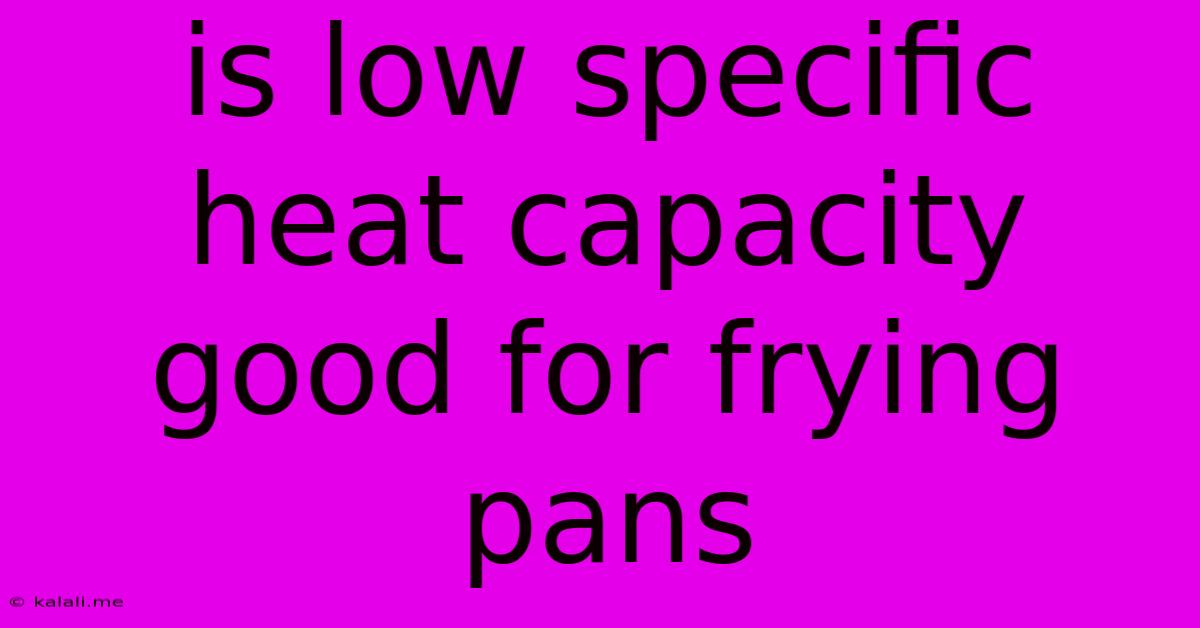Is Low Specific Heat Capacity Good For Frying Pans
Kalali
Jun 02, 2025 · 3 min read

Table of Contents
Is Low Specific Heat Capacity Good for Frying Pans? A Deep Dive into Pan Materials
Choosing the right frying pan can significantly impact your cooking experience. One crucial factor often overlooked is the material's specific heat capacity. This article delves into what specific heat capacity means, why it matters for frying pans, and whether a low specific heat capacity is truly beneficial. Understanding this will help you make an informed decision when buying your next pan.
Specific heat capacity refers to the amount of heat energy required to raise the temperature of one gram of a substance by one degree Celsius (or one Kelvin). Materials with a low specific heat capacity heat up quickly and cool down quickly, while those with a high specific heat capacity take longer to heat up and retain heat for longer periods.
Why Specific Heat Capacity Matters in Frying Pans
The ideal specific heat capacity for a frying pan depends on your cooking style and preferences. However, understanding its role is critical:
-
Faster Heating: Pans with low specific heat capacity, like those made of cast iron or carbon steel, heat up rapidly. This is advantageous for searing meat, quickly browning vegetables, and achieving those perfectly crisp edges. This rapid heating translates to faster cooking times and better efficiency in the kitchen.
-
Precise Temperature Control: While fast heating is beneficial, it also presents a challenge. A low specific heat capacity can make it harder to maintain a consistent temperature, especially on high heat. This requires more attention and control from the cook.
-
Even Heating: Even heat distribution across the pan is essential for consistent cooking. While specific heat capacity directly influences how quickly a pan heats, its impact on even heating is indirect. Factors like material thickness and construction play a much larger role in even heating. A low specific heat capacity pan can still have uneven heating if it's poorly designed.
Low Specific Heat Capacity: Good or Bad?
There's no simple "yes" or "no" answer. A low specific heat capacity offers advantages for certain cooking styles but presents challenges for others.
Advantages of Low Specific Heat Capacity:
- Faster Cooking: Perfect for stir-fries, searing, and quick-cooking methods.
- Crispier Results: The rapid heating contributes to crispier edges on meats and vegetables.
- Energy Efficiency (Potentially): Faster heating potentially translates to less energy consumed for the same cooking task.
Disadvantages of Low Specific Heat Capacity:
- Temperature Fluctuations: More challenging to maintain a consistent temperature, requiring more attention and skill from the cook.
- Hot Spots: Poorly constructed pans with low specific heat capacity can develop hot spots, leading to unevenly cooked food.
- Less Forgiveness: There's less room for error; minor temperature adjustments can significantly affect the outcome.
Material Considerations:
Let's examine some common frying pan materials and their specific heat capacities:
-
Cast Iron: Known for its excellent heat retention (high specific heat capacity) and even heating, but takes longer to heat up.
-
Carbon Steel: Offers a balance; heats up faster than cast iron but retains heat reasonably well.
-
Aluminum: Heats up very quickly (low specific heat capacity) but can have issues with even heating and may not be as durable.
-
Stainless Steel: Heats up relatively slowly (high specific heat capacity) and offers good durability, often combined with other metals for better heat distribution.
-
Copper: Excellent heat conductor (low specific heat capacity) known for its even heating but is expensive.
Conclusion:
The "goodness" of a low specific heat capacity in a frying pan is subjective and depends on your individual cooking habits and priorities. If you prioritize speed, crispier results, and are comfortable managing temperature fluctuations, then a pan with a low specific heat capacity might be suitable. However, if even heating and consistent temperature control are your priorities, a material with a higher specific heat capacity might be a better choice. Consider your cooking style and the trade-offs before making your purchase. Remember that factors beyond specific heat capacity, such as material composition, pan construction, and even the thickness of the base, are equally important in determining overall performance.
Latest Posts
Latest Posts
-
Santiagos Catch Old Man And The Sea
Jun 04, 2025
-
Bash Ulimit Open Files Cannot Modify Limit Operation Not Permitted
Jun 04, 2025
-
Why Does My Smoke Detector Keep Beeping
Jun 04, 2025
-
How Much Does A Motor Weigh
Jun 04, 2025
-
06 Chevy Silverado Radio Wiring Diagram
Jun 04, 2025
Related Post
Thank you for visiting our website which covers about Is Low Specific Heat Capacity Good For Frying Pans . We hope the information provided has been useful to you. Feel free to contact us if you have any questions or need further assistance. See you next time and don't miss to bookmark.